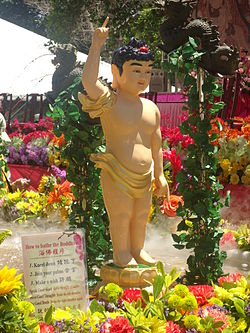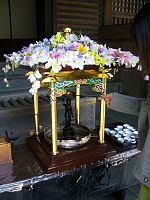- Buddha's Birthday
-
- This article deals with the East Asian holiday. See also Vesak.
Buddha's Birthday
A statue of the child Gautama Buddha as depicted in his apocryphal story of birthOfficial name Fódàn (佛誕)
Hut-a-sen (佛仔生)
Phật Đản
Chopa-il (초파일, 初八日)Also called Buddha's Birthday Observed by Mahayana Buddhists Type Buddhist Significance Celebrates the birthday of Gautama Buddha Date 8th day of the 4th lunar month
April 8 or May 8 (Japan)2010 date May 21 2011 date May 10 2012 date April 28 Related to Vesak Buddha's Birthday Chinese name Traditional Chinese 佛誕 Simplified Chinese 佛诞 Transcriptions Mandarin - Hanyu Pinyin fó dàn Cantonese (Yue) - Jyutping fātdáan Alternative Chinese name Chinese 佛仔生[1] Transcriptions Min - Hokkien POJ Hu̍t-á-seⁿ or Hu̍t-á-siⁿ Vietnamese name Quốc ngữ Phật Đản Buddha's Birthday, the birthday of the Prince Siddhartha Gautama, is a holiday traditionally celebrated in Mahayana Buddhism.
Contents
Date
East Asia except Japan
In all east Asian countries, except Japan beginning in 1873, it is held on the 8th day of the 4th month in the Chinese lunar calendar, and the day is an official holiday in Hong Kong, Macau, and South Korea. The date varies from year to year in the Gregorian calendar:
- 2011: May 10
- 2012: April 28
- 2013: May 17
- 2014: May 6
- 2015: May 25
Japan
Japan adopted the Gregorian calendar rather than the Chinese lunar calendar in 1873. The 4th month in the Chinese lunar calendar is translated into April or May. Therefore Buddha's birth is celebrated on April 8 or May 8 in many Japanese temples, and rarely on the orthodox Chinese calendar date.
Celebrations in each Country
Nepal
The birth of the Buddha is often celebrated by Buddhists in Nepal for an entire month in the Buddhist calendar. The actual day is called Buddha Poornima (or Buddha Purnima), also traditionally known as Vaishakh Poornima. Although the day marks not just the birth of Shakyamuni Gautam Buddha, but also the day of Enlightenment, and Mahaparinirvana. But as a gentle effect of West, the event of Birth is given paramount importance.
The event is celebrated by gentle and serene fervour, keeping in mind the very nature of Buddhism. People, especially women, go to common Viharas to observe a rather longer-than-usual, full-length Buddhist sutra, as something like a service. The usual dress is pure white. Non-vegetarian food is normally avoided. Kheer, a sweet rice porridge is commonly served to recall the story of Sujata, a maiden who, in Gautama Buddha's life, offered the Buddha a bowl of milk porridge after he had given up the path of asceticism following six years of extreme austerity. This event was one major link in his enlightenment.
It is said that the Buddha originally followed the way of asceticism to attain enlightenment sooner, as was thought by many at that time. He sat for a prolonged time with inadequate food and water, which caused his body to shrivel so as to be indistinguishable from the bark of the tree that he was sitting under. Seeing the weak Siddhartha Gautama, a girl named Sujata placed a bowl of milk in front of him as an offering. Realising that without food one can do nothing, the Buddha refrained from harming his own body.
India
Birth of Buddha or Tathagata is celebrated in India, especially in Sikkim, Ladakh , Arunachal Pradesh, Bodh Gaya and Maharashtra (where 6% of total population are Buddhists) and other parts of India as per Indian calendar. Buddhist People go to common Viharas to observe a rather longer-than-usual, full-length Buddhist sutra, as something like a service. The usual dress is pure white. Non-vegetarian food is normally avoided. Kheer, a sweet rice porridge is commonly served to recall the story of Sujata, a maiden who, in Gautama Buddha's life, offered the Buddha a bowl of milk porridge.
Japan
In Japan, Buddha's birth is also celebrated according to the Buddhist calendar but is not a national holiday. On this day, all temples hold Kanbutsu-e (Japanese: 灌仏会), 降誕会 (Goutan-e), 仏生会 (Busshou-e), 浴仏会 (Yokubutsu-e), 龍華会 (Ryuge-e), 花会式 (Hana-eshiki) or 花祭(Hana-matsuri, meaning 'Flower Festival'). The first event was held at Asuka-dera in 606. Japanese people pour ama-cha (a beverage prepared from a variety of hydrangea) on small Buddha statues decorated with flowers, as if bathing a newborn baby.
Korea
In Korea the birthday of Buddha is celebrated according to the Lunisolar calendar. This day is called 석가탄신일 (Seokga tansinil), meaning "the day of Buddha's birthday" or 부처님 오신 날 (Bucheonim osin nal) meaning "Welcome Buddha Day". Lotus lanterns cover the entire temple throughout the month which are often flooded down the street. On the day of Buddha's birth, many temples provide free meals and tea to all visitors. The breakfast and lunch provided are often sanchae bibimbap.
Sri Lanka
This is one of the major festivals in Sri Lanka. It is celebrated on the first full moon day of the month of May. People engage in religious observances and decorate houses and streets with candles and specially made lanterns. some stores give out free meals for people. In specific places, there are buildings made out of light bulbs but from a distance it represents pictures from the Buddha's life. They are called vesak thorun (Pandals). People sings songs called "bhakthi geetha".
Other countries
Some places have a public holiday one week later, on the fifteenth day of the fourth month in the Chinese Lunar Calendar, to coincide with the full moon. The names for this festival vary with each country, for instance Visakha Puja in Thailand or Lễ Phật đản in Vietnam. In some countries it is a public holiday.
See Vesākha for more information.
See also
- Public holidays in India
- Public holidays in Hong Kong
- Bun Festival - a festival held on the same day in Hong Kong.
- Public holidays in Macau
- Public holidays in South Korea
- Holidays in Taiwan
- Holidays of Japan
- Public holidays in Myanmar
- Holidays in Vietnam
- Public holidays in Thailand
- Public holidays in Sri Lanka
- Public holidays in Bhutan
- Vesak
References
- The Folkloric Study of Chopail (Buddha's Birthday), written by Prof. M.Y.Pyeon. Produced by Minsokwon in Seoul Korea 2002.
Gautama Buddha Teachings · Birthday · Four sights · Physical characteristics · Footprint · Buddha statue · Iconography · Films · Miracles · Disciples · Family · Places · Gautama Buddha in world religionsNew Year's Day · Lunar New Year (3 days) · Ching Ming Festival · Good Friday · The day following Good Friday · Easter Monday · The Birthday of the Buddha · Labour Day · Tuen Ng Festival · Hong Kong Special Administrative Region Establishment Day · The day following the Chinese Mid-Autumn Festival · National Day · Chung Yeung Festival · Christmas Day · The first weekday after Christmas DayCategories:- Buddhist holidays
- Buddhist festivals
- Holidays in Hong Kong
- Holidays in South Korea
- April observances
- May observances
Wikimedia Foundation. 2010.



